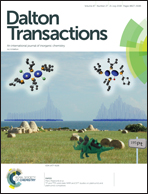3D LnIII-MOFs: slow magnetic relaxation and highly sensitive luminescence detection of Fe3+ and ketones†
Abstract
Five new 3D isostructural lanthanide metal organic frameworks (Ln-MOFs), [Ln(HL)1.5(H2O)(DMF)]·2H2O (Ln = GdIII (1), SmIII (2), DyIII (3), EuIII (4) and TbIII (5), H3L = 5-(3′,5′-dicarboxylphenyl) nicotinic acid) were synthesized by solvothermal methods and studied by structural analyses, magnetic analyses and luminescence sensing. Crystallographic studies revealed that these compounds are 3D frameworks in which the LnIII-COO chains with alternating four and two carboxylate bridges are interlinked by the organic ligands L, and contain microporous channels with accessible Lewis-base sites, coordinated water molecules and uncoordinated carboxyl groups, which are easy to combine and recognise various analytes. Magnetic studies demonstrated that the carboxylate bridges transmit interchain dominant ferromagnetic interactions in Gd-MOF (1) and Dy-MOF (3), while the decrease of the χT value in Sm-MOF (2) is due to the thermal depopulation effect of the excited levels. Furthermore, Dy-MOF (3) also shows slow magnetic relaxation behaviour under a zero dc field. The luminescence selective sensing experiments showed that Eu-MOF (4) and Tb-MOF (5) can act as recyclable sensors towards Fe3+ ions in water and the simulated biological fluids, and towards ketones in a water system with high sensitivity, selectivity and relatively low detection limits.

- This article is part of the themed collection: Spotlight Collection: Lanthanide and transition metal complexes as molecular magnets


 Please wait while we load your content...
Please wait while we load your content...